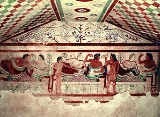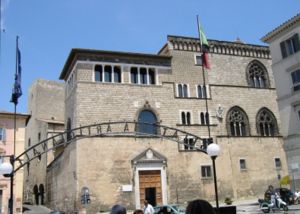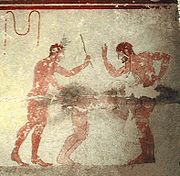
Tarquinia
Encyclopedia
Tarquinia, formerly Corneto and in Antiquity Tarquinii, is an ancient city in the province of Viterbo
, Lazio, Italy
.
Tarchnal) is said to have been already a flourishing city when Demaratus of Corinth brought in Greek workmen. It was the chief of the twelve cities of Etruria
.
Descendants of Demaratus, Lucius Tarquinius Priscus and Lucius Tarquinius Superbus
became kings of ancient Rome
. From Tarquinii many of the religious rites and ceremonies of Rome are said to have been derived, and even in imperial times a collegium of sixty haruspices continued to exist there.
In 509 BC, after the overthrow of the Roman monarchy, the family of Tarquinius Superbus went into exile in Caere
in Etruria. Tarquin sought to regain the throne, at first by the Tarquinian conspiracy
and, when that failed, by force of arms. He convinced the cities of Tarquinii and Veii
to support him, and led their armies against Rome in the Battle of Silva Arsia
. Although the Roman army was victorious, it is recorded by Livy
that the forces of Tarquinii fought well on the right wing, initially pushing back the Roman left wing. After the battle the forces of Tarquinii returned home.
 In 358 BC
In 358 BC
the citizens of Tarquinii captured and put to death 307 Roman soldiers; the resulting war ended in 351 with a forty years' truce, renewed for a similar period in 308. When Tarquinii came under Roman domination is uncertain, as is also the date at which it became a municipality; in 181 BC
its port, Graviscae (mod. Porto Clementino), in an unhealthy position on the low coast, became a Roman colony. It exported wine and carried on coral fisheries. Nor do we hear much of it in Roman times; it lay on the hills above the coast road. The flax and forests of its extensive territory are mentioned by classical authors, and we find Tarquinii offering to furnish Scipio
with sailcloth in 195 BC. A bishop of Tarquinii is mentioned in 456.
The original site of the Etruscan city of Tarquinia, known as the "Civita", is on the long plateau to the north of the current town. The two coexisted for most of the early Middle Ages, with Tarquinia dwindling to a small fortified settlement on the "Castellina" location, and the more strategically placed Corneto (possibly the "Corito" mentioned in Roman sources) growing progressively to become the major city of the lower Maremma sea coast, especially after the destruction of the port of Centumcellae (modern Civitavecchia). The last historic references to Tarquinia are from around 1250, while the name of Corneto was changed to Tarquinia in 1922. Reversion to historical place names (not always accurately), was a frequent phenomenon under the Fascist Government of Italy as part of the nationalist campaign to evoke past glories.

yield of 12 tonnes/ha with finished wines needing a minimum 10.5% alcohol level. The reds are a blend of at least 60% Sangiovese
and/or Montepulciano
, up to 25% Cesanese and up to 30% of other local red grape varieties. The whites are composed of at least 50% Trebbiano
and/or Giallo, up to 35% Malvasia
and up to 30 other local grape varieties with the exception of Pinot grigio that is specifically excluded from the DOC wines of Tarquinia.
Province of Viterbo
The Province of Viterbo is a province in the Lazio region of Italy. Its capital is the city of Viterbo. It is bordered to the north by the Province of Grosseto and Siena, by the north-east with the Province of Terni and Rieti, in the west by the Tyrrhenian Sea and south by the Province of Rome.It...
, Lazio, Italy
Italy
Italy , officially the Italian Republic languages]] under the European Charter for Regional or Minority Languages. In each of these, Italy's official name is as follows:;;;;;;;;), is a unitary parliamentary republic in South-Central Europe. To the north it borders France, Switzerland, Austria and...
.
History
Tarquinii (EtruscanEtruscan language
The Etruscan language was spoken and written by the Etruscan civilization, in what is present-day Italy, in the ancient region of Etruria and in parts of Lombardy, Veneto, and Emilia-Romagna...
Tarchnal) is said to have been already a flourishing city when Demaratus of Corinth brought in Greek workmen. It was the chief of the twelve cities of Etruria
Etruscan cities
Etruscan cities flourished over most of Italy during the Roman Iron Age, marking the farthest extent of Etruscan civilization. They were gradually assimilated first by Italics in the south, then by Celts in the north and finally in Etruria itself by the growing Roman Republic.That many Roman cities...
.
Descendants of Demaratus, Lucius Tarquinius Priscus and Lucius Tarquinius Superbus
Lucius Tarquinius Superbus
Lucius Tarquinius Superbus was the legendary seventh and final King of Rome, reigning from 535 BC until the popular uprising in 509 BC that led to the establishment of the Roman Republic. He is more commonly known by his cognomen Tarquinius Superbus and was a member of the so-called Etruscan...
became kings of ancient Rome
Ancient Rome
Ancient Rome was a thriving civilization that grew on the Italian Peninsula as early as the 8th century BC. Located along the Mediterranean Sea and centered on the city of Rome, it expanded to one of the largest empires in the ancient world....
. From Tarquinii many of the religious rites and ceremonies of Rome are said to have been derived, and even in imperial times a collegium of sixty haruspices continued to exist there.
In 509 BC, after the overthrow of the Roman monarchy, the family of Tarquinius Superbus went into exile in Caere
Caere
Caere is the Latin name given by the Romans to one of the larger cities of Southern Etruria, the modern Cerveteri, approximately 50-60 kilometres north-northwest of Rome. To the Etruscans it was known as Cisra and to the Greeks as Agylla...
in Etruria. Tarquin sought to regain the throne, at first by the Tarquinian conspiracy
Tarquinian conspiracy
The Tarquinian conspiracy was a conspiracy amongst a number of senators and leading men of ancient Rome in 509 BC to reinstate the monarchy, and to put Lucius Tarquinius Superbus back on the throne. The conspirators were discovered and executed...
and, when that failed, by force of arms. He convinced the cities of Tarquinii and Veii
Veii
Veii was, in ancient times, an important Etrurian city NNW of Rome, Italy; its site lies in Isola Farnese, a village of Municipio XX, an administrative subdivision of the comune of Rome in the Province of Rome...
to support him, and led their armies against Rome in the Battle of Silva Arsia
Battle of Silva Arsia
The Battle of Silva Arsia was a battle in 509 BC between the republican forces of ancient Rome on the one hand, and Etruscan forces of Tarquinii and Veii led by the deposed Roman king Lucius Tarquinius Superbus on the other...
. Although the Roman army was victorious, it is recorded by Livy
Livy
Titus Livius — known as Livy in English — was a Roman historian who wrote a monumental history of Rome and the Roman people. Ab Urbe Condita Libri, "Chapters from the Foundation of the City," covering the period from the earliest legends of Rome well before the traditional foundation in 753 BC...
that the forces of Tarquinii fought well on the right wing, initially pushing back the Roman left wing. After the battle the forces of Tarquinii returned home.

358 BC
Year 358 BC was a year of the pre-Julian Roman calendar. At the time, it was known as the Year of the Consulship of Ambustus and Proculus...
the citizens of Tarquinii captured and put to death 307 Roman soldiers; the resulting war ended in 351 with a forty years' truce, renewed for a similar period in 308. When Tarquinii came under Roman domination is uncertain, as is also the date at which it became a municipality; in 181 BC
181 BC
Year 181 BC was a year of the pre-Julian Roman calendar. At the time it was known as the Year of the Consulship of Cethegus and Tamphilus...
its port, Graviscae (mod. Porto Clementino), in an unhealthy position on the low coast, became a Roman colony. It exported wine and carried on coral fisheries. Nor do we hear much of it in Roman times; it lay on the hills above the coast road. The flax and forests of its extensive territory are mentioned by classical authors, and we find Tarquinii offering to furnish Scipio
Scipio Africanus
Publius Cornelius Scipio Africanus , also known as Scipio Africanus and Scipio the Elder, was a general in the Second Punic War and statesman of the Roman Republic...
with sailcloth in 195 BC. A bishop of Tarquinii is mentioned in 456.
The original site of the Etruscan city of Tarquinia, known as the "Civita", is on the long plateau to the north of the current town. The two coexisted for most of the early Middle Ages, with Tarquinia dwindling to a small fortified settlement on the "Castellina" location, and the more strategically placed Corneto (possibly the "Corito" mentioned in Roman sources) growing progressively to become the major city of the lower Maremma sea coast, especially after the destruction of the port of Centumcellae (modern Civitavecchia). The last historic references to Tarquinia are from around 1250, while the name of Corneto was changed to Tarquinia in 1922. Reversion to historical place names (not always accurately), was a frequent phenomenon under the Fascist Government of Italy as part of the nationalist campaign to evoke past glories.

Tarquinia DOC
The Italian wine DOC of Tarquinia produces red, white frizzante style wine. The grapes are limited to a harvestHarvest (wine)
The harvesting of wine grapes is one of the most crucial steps in the process of winemaking. The time of harvest is determined primarily by the ripeness of the grape as measured by sugar, acid and tannin levels with winemakers basing their decision to pick based on the style of wine they wish to...
yield of 12 tonnes/ha with finished wines needing a minimum 10.5% alcohol level. The reds are a blend of at least 60% Sangiovese
Sangiovese
Sangiovese is a red Italian wine grape variety whose name derives from the Latin sanguis Jovis, "the blood of Jove"...
and/or Montepulciano
Montepulciano (grape)
Montepulciano is a red Italian wine grape variety that is most noted for being the primary grape behind the Denominazione di Origine Controllata e Garantita wine Montepulciano d'Abruzzo Colline Teramane and the Denominazione di origine controllata wines of Rosso Conero and Rosso Piceno.It should...
, up to 25% Cesanese and up to 30% of other local red grape varieties. The whites are composed of at least 50% Trebbiano
Trebbiano
Trebbiano is the second most widely planted grape in the world. It gives good yields, but makes undistinguished wine at best. It can be fresh and fruity, but does not keep long. Its high acidity makes it important in Cognac production...
and/or Giallo, up to 35% Malvasia
Malvasia
Malvasia is a group of wine grape varieties grown historically in the Mediterranean region, Balearic islands, Canary Islands and the island of Madeira, but now grown in many of the winemaking regions of the world...
and up to 30 other local grape varieties with the exception of Pinot grigio that is specifically excluded from the DOC wines of Tarquinia.
Main sights
- The Etruscan necropolises, with some 6,000 tombs, 200 of which include wall paintings. The main site is the Necropolis of Monterozzi, with a large number of tumulusTumulusA tumulus is a mound of earth and stones raised over a grave or graves. Tumuli are also known as barrows, burial mounds, Hügelgrab or kurgans, and can be found throughout much of the world. A tumulus composed largely or entirely of stones is usually referred to as a cairn...
tombs with chambers carved in the rock. The scenes painted include erotical and magic depictions, landscapes, dances and music. There are also carved sarcophagi, some dating to the Hellenistic period. Main tombs included the Tomba della FustigazioneTomba della FustigazioneTomba della Fustigazione, or "Tomb of Flogging" in English, is an Etruscan burial site from the Monterozzi Necropolis near the ancient city of Tarquinia, in central Italy...
and the Tomb of the LeopardsTomb of the LeopardsThe Tomb of the Leopards is an Etruscan burial chamber so called for the confronted leopards painted above a banquet scene. The tomb is located within the Monterozzi necropolis and dates to around 480–450 BC...
. - Remains of the Ara della Regina ("Altar of the Queen") temple, measuring c. 44 x 25 m and dating to c. 4th-3rd century BC. IT was built in tuffTuffTuff is a type of rock consisting of consolidated volcanic ash ejected from vents during a volcanic eruption. Tuff is sometimes called tufa, particularly when used as construction material, although tufa also refers to a quite different rock. Rock that contains greater than 50% tuff is considered...
with wooden structures and decorations. Also traces of the Etruscan walls (c. 8th century BC) exist: they had a length of some 8 km. - The National Museum, with a large collection of archaeological findings. It is housed in the Renaissance Palazzo Vitelleschi, begun in 1436 and completed around 1480-1490
- Church of Santa Maria di Castello (1121–1208), with Lombard and CosmatesqueCosmatesqueCosmatesque, or Cosmati, is a style of geometric decorative inlay stonework typical of Medieval Italy, and especially of Rome and its surroundings. It was used most extensively for the decoration of church floors, but was also used to decorate church walls, pulpits, and bishop's thrones...
influences. The façade has a small bell-tower and three entrances. The interior has a nave and two aisles, divided by massive pilasters with palaeo-Christian capitals and friezes. Noteworthy are also the rose-window in the nave and the several marble works by Roman masters. - The Cathedral, once in Romanesque-Gothic style but rebuilt after the 1643 fire, has maintained from the original edifice the 16th century frescoes in presbitery, by Antonio del MassaroAntonio del MassaroAntonio del Massaro da Viterbo, or Antonio da Viterbo, nicknamed il Pastura was an Italian painter.-Life and career:...
. - Church of San Giacomo and Santissima Annunziata, showing different Arab and Byzantine influences.
- The small church of San Martino (12th century).
- The church of St. John the Baptist (12th century), with an elegant rose-window in the simple façade.
- The Communal Palace, in Romanesque style, begun in the 13th century and restored in the 16th.
- The numerous medieval towers, including that of Dante AlighieriDante AlighieriDurante degli Alighieri, mononymously referred to as Dante , was an Italian poet, prose writer, literary theorist, moral philosopher, and political thinker. He is best known for the monumental epic poem La commedia, later named La divina commedia ...
. - The Palazzo dei Priori. The façade, remade in Baroque times, has a massive external staircase. The interior has a fresco cycle from 1429.
- The Gothic-Romanesque church of San Pancrazio.
External links
- Official website
- Awayaway.com, Tarquinia - ancient history of Italy: descriptions of some Etruscan tombs
- Uchicago.edu (3 chapters of George Dennis's Cities and Cemeteries of Etruria)
- Discoversoriano.com, Information about Tarquinia's Cattle Branding Festival

